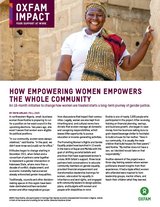As a development organization we must be accountable not only to our donors, but also to the people on whose behalf we work—the people at the center of our programs. In late 2005, Oxfam established a department dedicated to learning, evaluation, and accountability. Since that time we have been making increased investments in this area. Now all long-term programs, major campaigns, and key innovation projects have a rigorous monitoring, evaluation, and learning system. Most include:
- A baseline or assessment of the situation prior to intervention
- A monitoring system with quarterly or midterm reports documenting progress in relation to plans
- Annual reviews that document aggregate evidence and that bring stakeholders together for reflections on progress
- An evaluation every three to four years and/or when an initiative finishes
Interested in learning even more about how Oxfam measures impact? Explore our research, evaluations, and impact reports.




Spread the word
Help us build a global movement for change.